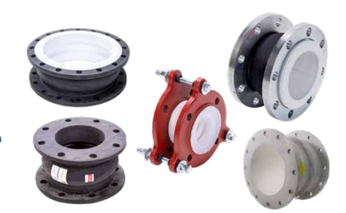Recent regulations in the US and Europe address Per and Polyfluoro Alkyl Substances (PFAS). While some PFAS pose health risks, safe options like fluoropolymers and elastomers are crucial in various sealing devices. This paper discusses their significance and potential industrial implications amidst evolving regulations.
By Phil Mahoney, Director of Engineering Services, Stationary Equipment, A.W. Chesterton, and Fluid Sealing Association, Chair of Government Affairs and PFAS Task Force; and Michael Wachinger, Senior Regional Manager ANZ/SEA, A.W. Chesterton Company

PFAS stands for Per and Poly FluoroAlkyl Substances. There are many contradictory definitions for this; however, the most common in use is “a synthetic chemical compound group with at least one fully fluorinated carbon atom.” Depending on the definition, the number of chemicals under the PFAS umbrella can be between 4,700 and 10,000+ chemicals. According to some industry experts, 10% of those are in commercial products internationally in various forms. The carbon-fluorine bond used in PFAS is one of the strongest in chemistry, resulting in incredibly useful and unique properties. This molecular structure also means they do not readily break down in nature; hence, the term sometimes used is “forever chemicals”. There are two categories of PFAS material: non-polymers and polymers. Non-polymer PFAS generally fall into two classes:
- Per: Fluorine atoms are replacing all hydrogen atoms that are linked to all carbon atoms in a chain (other than those associated with a functional group).
- Poly: Fluorine atoms are replacing all hydrogen atoms linked to at least one carbon atom in a chain (other than those associated with a functional group).
Polymers classed as Fluoropolymers have fluorines attached directly to the carbon-only backbone, Perfluoropolyether have additional oxygen atoms, and side-chain fluorinated polymers have a variety of fluorinated side chains.
PFAS risk
Extensive research has identified potential health risks from long-term exposure to certain non-polymeric PFAS materials, such as PFOS and PFOA, currently categorised as persistent organic pollutants (POPs) in the EU. These substances have been detected in various environmental sources. However, further investigation is required to establish exposure’s precise causes and effects and differentiate hazardous from non-hazardous PFAS materials.
PFOA has not been commercially utilised by major producers for nearly a decade in the USA. PFOS is commonly found in firefighting foams, but it is not a typical component in USA-manufactured sealing devices.
Note that not ALL PFAS are considered hazardous. Polytetrafluoroethylene (PTFE) and fluoroelastomers fall within the polymer category of PFAS, characterised by their high molecular weight, non-bioavailability, and non-toxic nature. They are often called ‘polymers of low concern’ and have a long history of safe use in diverse applications, from medical devices to aerospace and sealing devices. These polymers differ significantly from non-polymeric PFAS materials.

What is a sealing device?
Any device that prevents leaks from occurring in dynamic and static equipment components can be classified as a sealing device. Every pump, agitator, mixer, valve, or pipe run will have sealing to protect against:
- Aggressive chemicals
- Abrasive media
- Toxic or hazardous materials
- Gases/liquids/solids
- Harsh conditions
- Temperature extremes
- Full vacuum and extreme pressures
Sealing devices take many forms, from O-rings in mechanical seals to packing and gasket products to lip seals and expansion joints. Sealing devices are used in every industry, including:
- Power generation (fossil, nuclear, renewable)
- Water/wastewater
- Oil & gas (fugitive emissions)
- Chemical processing
- Mining/ore processing
- Pulp & paper
- Pharmaceutical
- Aerospace
- Semiconductor
- Military/defence
- HVACR
- Medical
- Any other industry with moving or stationary parts
There are two main channels for sealing devices: Original Equipment Manufacturers (OEMs) purchase them as a product component, and end users may replace them through aftermarket sources. As sealing devices are consumables, eventually, their performance will diminish and require replacement. When that happens, the end-users of the OEM products will either purchase new replacement products or procure replacement components (sealing devices), re-build the equipment during a maintenance cycle, and re-start the plant.


Why are fluoropolymers so important to sealing?
Since the early 1950s, Fluoropolymers like PTFE have found extensive use in various applications due to their exceptional sealing properties. Their versatility, low friction, chemical resistance, and high-temperature stability make them an ideal choice for various industrial uses.
Key properties of fluoropolymers include:
- Unmatched resistance to oxidation
- Imperviousness to most chemicals
- High-temperature stability
- Very low friction coefficient
- Excellent sealability
- Exceptional durability
- Long-lasting stability
- Resistance to degradation over time
Fluoropolymers are ideal for sealing devices, ensuring safety and effectiveness in various industrial applications. They offer durability and stability, reducing downtime. PTFE, for instance, minimises leakage, which is critical for sealing hazardous substances. Fluoropolymers
are prevalent in the global sealing market, addressing high replacement costs, estimated at around 30 billion USD annually.
What do legislators think?
Legislative efforts in the US and Europe aim to reduce and eliminate PFAS materials in manufacturing and products. However, most proposed legislation covers all PFAS forms rather than specifically targeting potentially harmful ones. While the intent is to address the risks posed by certain PFAS, regulating such a large group of chemicals is challenging. The one-size-fits-all approach needs revision since some PFAS are safe and essential for many applications.
In the EU, there’s a proposal to ban all PFAS for a specified period, allowing industry input. In the US, federal and state levels are working on PFAS regulation, but definitions and intent vary.
Discussions include a 1 part per trillion limit, but clarity is needed on testing frequency and measurement methods and accuracy. The lack of industrial standards and emotional-based regulations make distinguishing safe from unsafe materials difficult.
This uniform approach will challenge various industries, including sealing applications, and make replacing proven and safe technologies difficult. For instance, compliance with strict VOC regulations would be unattainable without fluoropolymers in high temperature sealing devices. Mandating the removal of ALL PFAS materials will bring significant changes to numerous industries worldwide.
Is it easy to replace the fluoropolymers in sealing devices?
The need for enhanced equipment uptime, reduced emissions, cost savings, and heightened safety is driving designers and manufacturers of sealing devices to develop more efficient and reliable products. With the increasing demand from new markets, it’s clear that fluoropolymers excel in their performance, with no known alternatives. For instance, the transition from LNG and LPG to hydrogen gas presents challenges due to the small size of hydrogen molecules, making sealing more difficult. Similarly, the unique nature of new biofuels requires the use of Fluoropolymers for effective sealing in emerging applications.
The demand for superior sealing performance continues to rise, particularly in achieving zero ppm emissions in low-emission valve sealing within the petrochemical industry. Eliminating fluoropolymers like PTFE from existing sealing solutions would prevent them from meeting emission requirements.
Replacement technologies
There is some effort aimed at promoting alternative equipment and technology, which is feasible in certain cases but not universally applicable. For example:
- Valves used for fluid control can have alternative sealing solutions, such as bellows and emerging technologies, but these often require additional space, new pipework, and flange adjustments. Retrofitting is feasible for some existing valves, but many plants have millions of installed valves, making these alternatives costly and complex.
- Replacing gaskets between flanges with pipe welding is a high-risk and costly activity. Properly selecting sealing materials for joints and interfaces is crucial for safety and performance. Incorrect material choices can lead to catastrophic incidents, risking lives and causing environmental, plant, and equipment damage.
- Sealless pumps like mag drives are an option but come at a higher cost and have pressure, temperature, and process fluid capabilities limitations.
- Fluoroelastomers are essential for sealing high-temperature applications above 150°C. Applications exceeding this temperature require fluoroelastomer-based materials, as silicone rubbers cannot handle high pressures and chemical environments. Fluoroelastomers excel in various chemical, heat, and pressure applications, making them the preferred choice.
Conclusion
As the world struggles with addressing PFAS materials, it is essential to note that not all PFAS are hazardous. A singular approach is not sensible for the future, especially with the increasing demand for necessary products containing fluoropolymers and fluoroelastomers, which are proven to be safe. These are necessary and hazard-free products that ensure sealing requirements are met.
The US Fluid Sealing Association (FSA), alongside the European Fluid Sealing Association (ESA), are using the following categorisation approach:
- Not all PFAS are problematic.
- Use of scientific testing methods to secure an acceptable result standard.
- Fluoropolymers and fluoroelastomers are essential to the sealing industry’s future.
The FSA and ESA will continue to work with committees, government agencies, and industrial conferences to agree on these three topics.
About the author
 Michael Wachinger currently serves as the Chesterton Asia Pacific Senior Regional Manager. Michael has 16 years’ experience in mechanical seal design, installation and applications across various industries including mining, oil and gas, and water. As a Scientific Instrument Maker by trade, Michael appreciates what it takes to help equipment remain operational and leak free, bringing an exceptional level of technical understanding to the elements of process control. Michael also holds a Bachelor of Business in Marketing, giving him an edge in understanding the financial and business decisions that make up technical solutions.
Michael Wachinger currently serves as the Chesterton Asia Pacific Senior Regional Manager. Michael has 16 years’ experience in mechanical seal design, installation and applications across various industries including mining, oil and gas, and water. As a Scientific Instrument Maker by trade, Michael appreciates what it takes to help equipment remain operational and leak free, bringing an exceptional level of technical understanding to the elements of process control. Michael also holds a Bachelor of Business in Marketing, giving him an edge in understanding the financial and business decisions that make up technical solutions.
References
1) Root T (15 June 2021). “Senate bill would ban toxic ‘forever chemicals’ in makeup, which new study found are often unlabeled”. The Washington Post article was Archived from the original on 16 June 2021 and retrieved on 2 July 2021.
2) White Paper data as of 05/23
About this Technical Story
This Technical Story is an article from our Valve World Magazine, May 2024 issue. To read other featured stories and many more articles, subscribe to our print magazine. Available in both print and digital formats. DIGITAL MAGAZINE SUBSCRIPTIONS ARE NOW FREE.
“Every week we share a new Technical Story with our Valve World community. Join us and let’s share your Technical Story on Valve World online and in print.”

